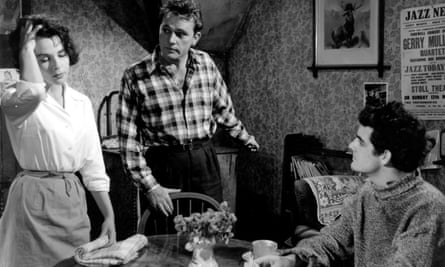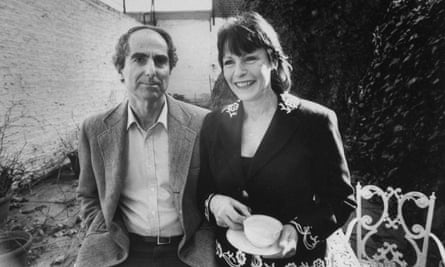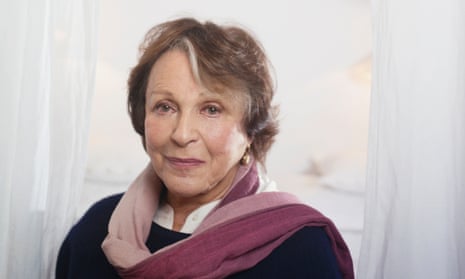‘Terror! Vice! Violence!” howls the poster for Claire Bloom’s 1953 film The Man Between, co-starring James Mason as Ivo Kern, shadowy smuggler of secrets and people in postwar Berlin. In the poster, he is putting the moves on Bloom, whom the artist has depicted reclining in rumpled sheets, hair down, thighs bared.
“It is fairly misleading!” says Bloom when I show her the poster she’s never seen before during lunch at Blakes hotel in Kensington. She’s right. Carol Reed’s follow-up to The Third Man is an existential meditation on human corruption. One that is being revived for a new audience.
Bloom was 22 at the time, and near the start of a remarkable career during which she would star with, among others, Chaplin, Gielgud, Burton, Olivier, Steiger, Brynner, Hopkins. “And some great women, too,” she adds, such as Kathryn Hunter and Eileen Atkins. She was also on the brink of a romantic odyssey anatomised in her 1996 memoir Leaving a Doll’s House. During it, she would marry three times (Rod Steiger, producer Howard Elkins and novelist Philip Roth), and have other affairs and dalliances, sometimes with her leading men, including Olivier, Burton and Brynner, not to mention a night of folly with Anthony Quinn.
Today, she is elegantly dressed and proves witty, friendly company; she is, generally, prepared to put up with the odd impertinent question. Only occasionally – say when asked about whether she and Burton were an item on the set of Alexander the Great – does she snap incontrovertibly: “Let’s not talk about that.” But moments later gives me the gossip anyway.
“I am,” she tells me several times, “of a certain age” (she is 85), and that serves both as a get-out for her garrulousness and a justification for forgetting some of the details of her career. For instance, she can remember many things about the 63-year-old The Man Between, but not the name of the character she played.

She was Susanne Mallison, a naive young Englishwoman who poses as a prostitute to avoid capture by Soviet thugs. “I loved that scene,” she laughs. “It was a great relief from being the nice, nice girl.”
When Bloom arrived in Berlin for filming, the producer and director Alexander Korda had just put her under contract. After training at the Guildhall and the Central School of Speech and Drama, she had played Ophelia in Stratford and Juliet at the Old Vic. The most celebrated critic of the day, Kenneth Tynan, wrote that hers was “the best Juliet I’ve ever seen”.
Bloom made her screen debut with a small role in Gainsborough Pictures’ 1948 film The Blind Goddess. Soon after, she enrolled – like Dirk Bogarde, Petula Clark and Diana Dors – in J Arthur Rank’s “charm school”, set up to manufacture British movie stars along Hollywood lines.
In 1952, she got her cinematic break. Chaplin had been searching for someone with “beauty, talent and a great emotional range” to play a suicidal ballerina suffering from hysterical paralysis who is rescued from the brink by, you’ve guessed it, his once-famous stage clown. He found those qualities in Bloom and the resulting film, Limelight, gave her an international profile.
The following year, with The Man Between, she was being groomed for stardom by Korda. Later, she wrote: “I believe that if he [Korda] had lived, I might have had films built around me that were suited to my qualities.” But initially he gave her a role she didn’t think suited her. “I didn’t want to play the young English innocent, but that’s what I did and it worked.” It was only in her second film with Korda, his 1955 adaptation of Richard III in which she played Lady Anne opposite Olivier, that she got “everything I could have wanted”. She thinks the film still holds up. “In that second scene of Richard there’s an extraordinary kind of magnetism between us and it comes over to this day.”
After Berlin, she returned to the Old Vic in London, where, between rehearsals, she fell in love with the married Richard Burton. At the time, if her memoirs are anything to go by, she remained the young English innocent. She wrote of her and Burton’s first night together: “I was almost ignorant about sexual matters, and found this first experience perplexing … Richard left me in the early morning to go back home and I went to sleep childishly thrilled that I was a ‘woman’ at last.”
Though their romance soon ended, their careers were long after intertwined. In the 1956 sword-and-sandals epic, Alexander the Great, Bloom played beautiful mistress Barsine to his all-conquering Macedonian. In Look Back in Anger, Tony Richardson’s 1959 adaptation of John Osborne’s play, Burton played Jimmy Porter, and Bloom was Helena, who becomes the angry young man’s mistress.
She loves the role. “She was a woman of today.” Bloom was given a freedom on set by Richardson she’d never experienced before. “I’d say: What do you think I should do?’ He’d say: ‘What do you think you should do? Do what you like.’”
In 1964, Burton and Bloom appeared together in the film adaptation of John le Carré’s The Spy Who Came in from the Cold. By then, Burton was married to Elizabeth Taylor and Bloom to Steiger, with whom she would have a daughter, Anna, now a renowned opera singer. Bloom relates how Burton told her that to wake and find Taylor on his pillow was like having Christmas every morning, “a sentiment”, wrote Bloom hilariously, “that raised in me urges akin to murder”.
“It didn’t make me feel too good,” she laughs.
She has starred in more than 60 films, not to mention plays and TV dramas including Doc Martin, Midsomer Murders and Doctor Who. Among her most famous roles were the girls – Juliet, Ophelia, Susanne from The Man Between. Then the women, starting with Look Back in Anger’s sexually confident Helena and then her performance as Nora in A Doll’s House, a role that allowed Bloom to “fuse two conflicting sides of my nature – spoiled-child wife and the determinedly independent woman”. She, like Nora, had to slam the door on a husband – but in her case, it happened three times.

The year after her Broadway triumph as Nora in the early 70s, she starred as the sexually troubled, fading southern belle Blanche DuBois in Tennessee Williams’s A Streetcar Named Desire. Bloom argues that she would never have understood the character properly but for her relationship with her second husband, Elkins, whose “entire being appeared to be centred on sexual gratification”.
Another significant performance has been her narration of Leonard Bernstein’s “Kaddish” Symphony No 3, in a performance conducted by his protégée Marin Alsop in 2013. It’s intriguing both as an exploration of Bloom’s Jewish heritage and as a near-sacrilegious work in which Bernstein writes verse raging against the Almighty for His feebleness at ending human suffering. “I was told by a composer friend that the kaddish is ‘Bernstein fights with God. Bernstein wins,” laughs Bloom.
Throughout lunch, I’ve been checking to see if she is still wearing the snake ring Roth gave her in the late 1980s. The couple had been living together for more than a decade when he presented her with the manuscript for his novel Deception. He then left it with her in their New York apartment.
She read it in mounting fury because it depicted an actor called Claire from a self-hating Jewish family whose writer husband cheats on her with a series of women Bloom describes as “east European seductresses”. When he returned, Bloom says she was shaking with rage, while Roth presented her with a gold snake ring with an emerald head he’d just bought from Bulgari on Fifth Avenue. Deception was published in 1990, the same year they were married (they divorced in 1995). It was only when Roth agreed to remove her name from the novel that she accepted the ring as “his guilt offering”.
Does she still read Roth’s books? “I don’t find it easy. I have gone back to read American Pastoral, which I had not read at the time. It’s a lovely, wonderful book. I find it hard.” How about I Married a Communist? “I certainly didn’t read that, if that’s what you’re asking.” In that 1998 novel, Eve Frame exposes her ex-husband as a communist during the McCarthy years. And then the outed commie takes his revenge. “Did she imagine,” snarls Roth’s narrator, “this openly aggressive hot head was going to do nothing in response?” Linda Grant in her Guardian review of the novel (under the heading “The wrath of Roth”) wrote that behind that question was another: “And did you, Roth is asking Claire Bloom, not expect me to retaliate?”
“I’ve nothing to say about Roth,” says Bloom, who has lived for the past 20 years in London. Though she goes on to tell me about a time, a few years ago, when she was at a loose end in Montreal, having arrived early for a movie she was to film, and spent the week at the cinema. She saw an adaptation of one of Roth’s novels – “The one with Nicole Kidman in it.” She means the 2003 adaptation of The Human Stain, in which Nathan Zuckerman, Roth’s fictional self-projection, is holed up in a New England cabin after suffering divorce and prostate cancer. “And the person who was supposed to be playing Philip was no more like him than you and I!” Zuckerman was played by Gary Sinise, who at the time was in his late 40s, while Roth would have been 70.
Writing in 1996, Bloom said she wore Roth’s ring “to this day”. But I notice she is not wearing it today. “A friend of mine said: ‘As long as you wear that ring you’ll never be free,’ so I sold it – immediately,” she says, before adding with a smile: “For very little.”

Comments (…)
Sign in or create your Guardian account to join the discussion